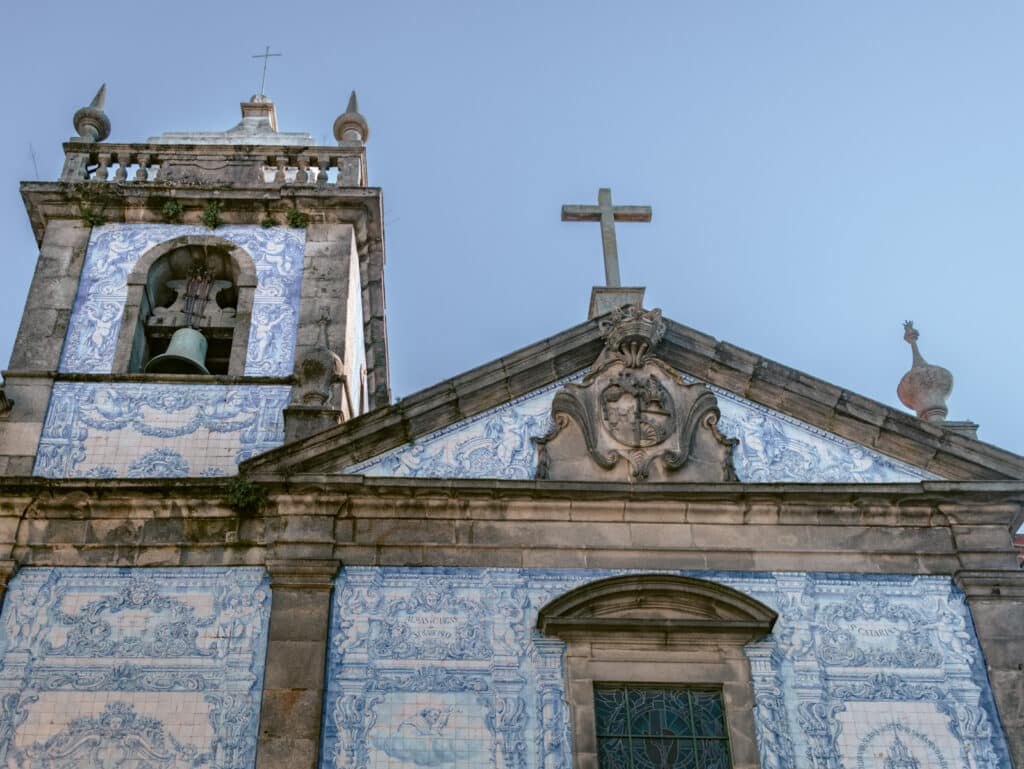Wondering where to find the best azulejos in Porto? Porto is a vibrant city in Portugal famous for its stunning architecture and beautiful landmarks. Apart from having great landscapes and spots, Porto has a distinguished feature used across most of the city’s architecture known as Azulejos. The vibrant blue tiles adorn many buildings and structures and make Porto stand out from other places in the world.
In this post, we’ll explore the history and significance of the azulejos found in Porto, as well as give you the ultimate guide to places where you can find them.
Historic churches, cultural venues, and even train stations, azulejos can be found anywhere in Porto!
This article may contain affiliate / compensated links. For full information, please see our disclosure here.
Azulejos In Porto Map
Save this map of all the azulejos in Porto that I have listed in this post. You can download this in your Google Maps app so you have it handy during your visit to Porto.
Where To Find Azulejos In Porto

In the colorful streets of Porto, the intricate blue azulejos decorate the facades of buildings. These traditional Portuguese tiles are known for their intricate patterns and vibrant hues of blue, making them a beloved sight throughout the city.
Here’s a list of places where you can find the most beautiful azulejos in Porto.
Igreja do Carmo


Igreja do Carmo is a beautiful church that has stunning tilework on its exterior. Featuring blue and white azulejos that showcase religious and historic scenes, which date back to the early 18th century.
Want to explore more than all the azulejos in Porto? See the city with my 2 days in Porto itinerary.
Bramica
Brahma is a unique mosaic of tiles from all over Portugal, located in the Ribeira district, created by artist Manuel Cargaleiro, and features bright tiles that adorn the place.
What makes this place so unique is that you can make your very own azulejos! So make sure you take the time to explore this incredible piece of Portuguese history at Brahma and make your own souvenir to take home.
Banco de Materiais
Banco de Materiais isn’t your traditional museum, but rather a collection of constructive and decorative elements from some of Porto’s most iconic buildings. It’s another spot to admire the beautiful azulejos in Porto.
The different azulejos available are by far impressive, especially on the Hispanic-Arab variety. And that’s not all, cast iron and stucco elements also grace the halls of this treasure trove of architectural history. Whether you’re an enthusiast or intrigued by the beauty and charm of the past, a visit to the Banco de Materiais is a must.
Related Post: What To Do In Aveiro
Porto Cathedral
The Porto Cathedral is a stunning monument with a unique history. After multiple renovations, it now blends Gothic, Roman, and Baroque designs.
You can find stunning blue and white tiles adorning the cathedral’s walls, making it one of the oldest collections of azulejos in Porto.
Capela das Almas


Capela das Almas, known as Chapel of Souls, is a neoclassical gem built in the 18th century, although the classic tilework was added in the 20th century.
The building’s unmistakable blue and white tile façade showcases the lives of Saint Francis of Assisi and Saint Catherine, making this church an unmissable attraction on Santa Catarina Street.
Explore beyond the azulejos in Porto. Eat your way through the city with my Porto food guide.
Casa da Música
Located in the heart of Porto, Casa da Musica is an architectural masterpiece that stands at the forefront of modern design. It doesn’t feature the classic Porto blue tiles on the outside, but once you enter the stunning marble structure, everything changes. In the VIP area, you’ll be surrounded by breathtaking azulejos decorating the walls and ceiling.
I recommend you check ticket availability to ensure you can get in, as it tends to get busy and sold out. If you’re looking for a budget-friendly alternative, you can take a stroll along Avenida da Boavista and admire some of Porto’s finest azulejos for free.
Sao Bento Train Station

My favorite spot to see the azulejos in Porto was at the Sao Bento Train Station. Here, over 20,000 tiles were used to create stunning murals in the 18th century designed by José Colaco. The train station is usually very busy, therefore if you’re looking to admire the tiles and take great photos without people nearby, make sure to arrive early.
Related Post: Portugal Instagram Captions
Igreja de Santo Ildefonso

Located on a small hill near Batalha Square, Igreja de Santo Ildefonso can be found, featuring 11,000 magnificent azulejo tiles. It was designed by Jorge Colaço, the same architect behind Porto’s renowned Sao Bento Train Station, and showcases the life of Saint Ildefonso and the Eucharist.
Igreja dos Congregados
Igreja dos Congregados is another church situated across from Sao Bento Railway station and close to Liberdade Square to spot azulejos in Porto. Its façade is adorned with blue and white azulejos, however, the interior is equally as impressive. To truly appreciate the stunning masterpieces, we suggest attending one of the masses held on Saturday or Sunday.
What Is The History Of Azulejos?

Azulejos were part of the Moorish culture, valued for their beauty and durability. Over the years, they became a symbol of luxury, adorning walls, floors, and ceilings of cathedrals, palaces, and homes.
They still hold a special place in artistic and cultural heritage today, with their unique designs and vibrant colors. Whether you’re looking to add a splash of color to your walls or create a stunning mosaic in your garden, azulejos can be used in many different ways.
Not sure where to stay during your visit? Find out where to stay in Porto here.
Why Are There So Many Tiles In Porto?
The blue and white azulejo tiles are sure to catch your eye as you’re strolling the streets of Porto, Portugal. You may wonder why are there so many tiles in Porto? Well, it all started in the 15th century, when the Moors brought the art of glazed ceramics to Portugal.
Over time, this art form became a staple in Portuguese culture, and they began using the tiles to decorate their homes, churches, and public buildings. In Porto, the use of azulejos became especially popular in the 18th and 19th centuries, with many buildings featuring intricate designs and scenes from Portuguese history.
Today, the beautiful azulejo tiles continue to add beauty and character to this picturesque city.
How Are Azulejos Used Today?
Azulejos are still widely used in many parts of the world today, from Portugal to Mexico and even further afield. In modern times, azulejos have become a popular choice for home decor.
Whether you’re looking to add a splash of color to your walls or create a stunning mosaic in your garden, azulejos can be used innovatively. So why not take inspiration from the past and inject a bit of old-world charm into your home?
Want to explore more of Portugal? You may enjoy these day trips from Porto ideas!
Does Azulejos Require Special Maintenance?
Azulejos are highly durable and resistant, although they require some special maintenance to remain in top condition. As with all glazed ceramics, cleaning your tiles regularly with a damp cloth or mild detergent is key to preventing wear and tear.
Additionally, it’s recommended to seal your tiles with a waterproofing sealant every few years to protect them from moisture and dirt. Following these steps will help ensure that your azulejos remain as beautiful as the day you installed them for many years to come!
Azulejos In Porto Final Thoughts
From the mesmerizing Bramica mosaic to the ornate interior of Sao Francisco Church and the Banco de Materiais, a visit wouldn’t be complete without taking the time to appreciate these stunning azulejos in Porto.
If you visit Porto, make sure you take the time to explore this fascinating part of its history and culture. With their vibrant colors and intricate designs, azulejos are sure to leave a lasting impression!
Like this post on azulejos in Porto? Share it with others or pin it for later!







